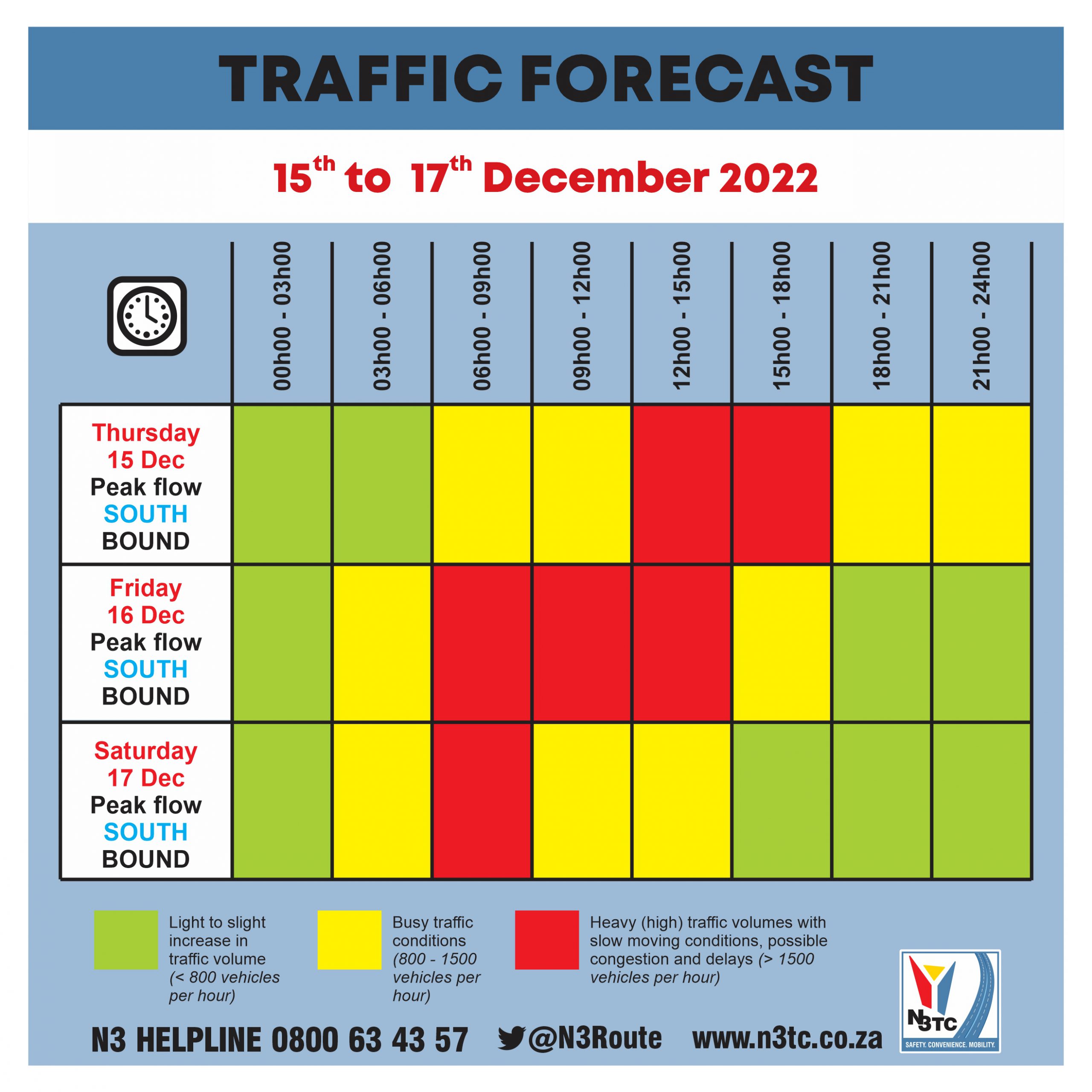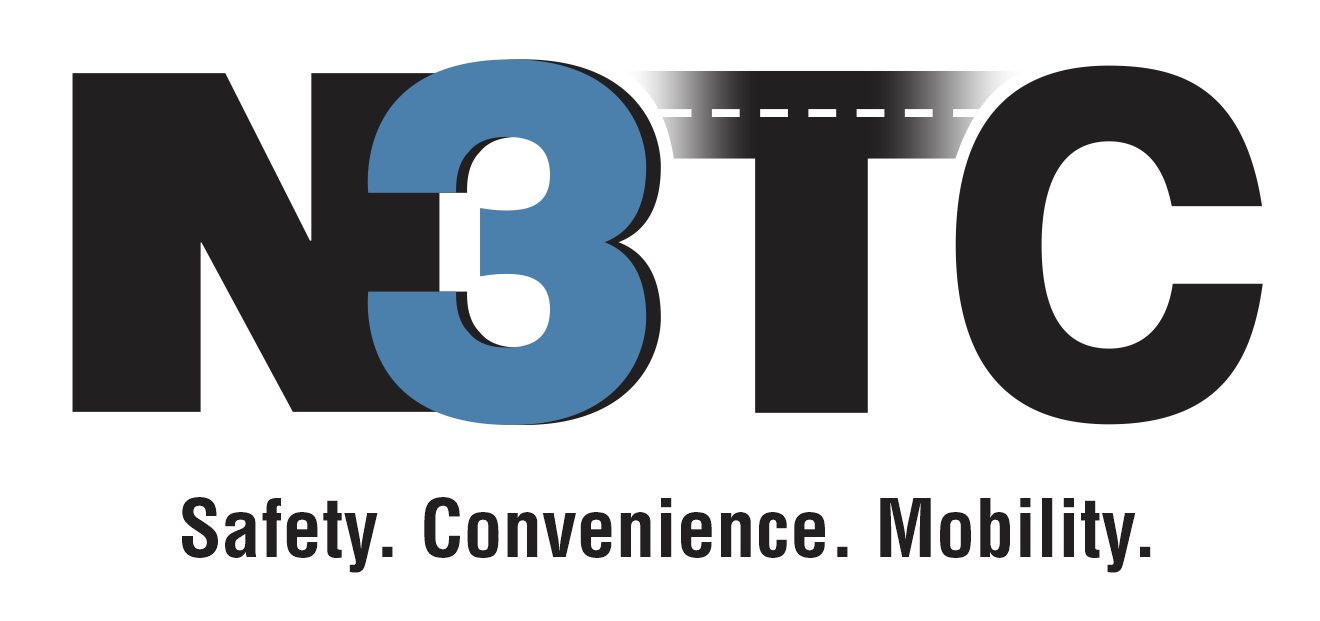N3 TOLL ROUTE UPDATE – PEAK TRAFFIC SEASON
15 DECEMBER 2022 – 03 JANUARY 2023
Plan ahead for high traffic volumes on the N3 Toll Route as SA’s peak holiday season commences
N3 Toll Concession (N3TC) is geared and ready for high traffic volumes as the annual peak holiday season gets into full swing this week.
Peak traffic conditions are expected southbound (towards KwaZulu-Natal) on the N3 Toll Route this week, on:
- Thursday, 15 December from 12:00 – 18:00
- Friday, 16 December from 06:00 – 15:00
- Saturday, 17 December from 06:00 – 09:00
High southbound volumes (more than 1500 vehicles per hour) can also be expected on 23 and 24 December as South Africans continue to make their way to the various holiday destinations, rural towns and villages connected to the N3 Toll Route.
Holidaymakers are expected to start their return journeys on Saturday, 31 December 2022. This will result in high volumes in a northbound direction (towards Gauteng). Peak conditions are expected to continue up to 03 January 2023; with volumes increasing once more on the weekend of 07 – 09 January 2023.
Construction and road works
All lanes on the N3 Toll Route will be open to traffic unless emergency repair- or maintenance work is required during this period. No scheduled construction work will be performed on the route during the festive season, from 15 December 2022 until 04 January 2023.
Toll plazas ready for maximum capacity
Toll plazas will operate at maximum capacity, but congestion and delays may be experienced at peak times. For increased mobility and safety, tag payments are accepted in all lanes at the De Hoek, Wilge, Tugela and Mooi mainline and ramp toll plazas. Other accepted payment methods include credit cards, fleet cards and cash. PLEASE NOTE: No payments with debit cards can be processed at any toll plaza in South Africa.
Additional pressure on drivers and traffic management resources
“Increased traffic volumes combined with a mix of vehicle types sharing the road, place additional demands on drivers, their passengers, emergency services, law enforcement agencies, and road management resources,” explains Thania Dhoogra, operations manager of N3TC.
“Slow-moving traffic, congestion and delays, driver inexperience or ineptitude, negligence, tiredness, concentration lapses, and unpredictable weather patterns all impact road safety.”
N3TC’s crash data for the first ten months of 2022, indicates that 79% of all light motor vehicle crashes and 85% of all truck crashes were attributed to driver ineptitude and/or negligence.
The majority (62%) of crashes were single-vehicle crashes where drivers lost control of their vehicles, and their vehicles either left the road or rolled.
Many of these crashes could have been avoided.
Risk perceptions, driving skills and the attitudes of drivers play an important part in attempts to reduce or prevent road crashes.
Concern about public transport crashes and head-on collisions
During the previous festive season, a steep rise in the number of public transport collisions was recorded. Crashes which included buses and/or minibus taxis were the highest recorded since 2017 (25% higher).
Public transport crashes have a significant detrimental impact on many lives as they involve a higher number of vulnerable road users, who are more likely to sustain fatal or serious injuries in a single incident.
On-going driver training and regular vehicle maintenance are essential to secure public transport safety. “Properly trained drivers in roadworthy vehicles perform better. They anticipate risks, and are better able to safely negotiate hazards,” explains Ms Dhoogra.
She also requests drivers to “take extra care to avoid head-on collisions, especially when travelling along undivided sections of the N3 carriageway, or at night.”
Head-on crashes are extremely dangerous because of the force of impact, and the seriousness of injuries sustained by drivers and their passengers. Injuries in these crashes are often life-altering in the form of spinal or brain injuries, or worse, the crashes are fatal.
In most cases, driver negligence is the cause of head-on crashes. Reckless driving, such as speeding and high-risk overtaking, driver fatigue, distractions and driver intoxication contribute to head-on crashes.
Deployment of road safety, emergency- and law enforcement support
Road incident management systems (RIMS), visible policing, and the deployment of emergency-, rescue-, medical-, disaster management-, and breakdown services are heightened during peak traffic periods on the N3 Toll Route.
All RIMS teams, including N3TC’s route services, will be stationed at key points along the route to render quick emergency assistance. Aero-medical and advanced life support teams will, where possible, provide additional support to paramedics on the ground.
Multi-disciplinary teams will be on duty at various traffic check points to perform driver fitness and vehicle roadworthiness tests, and to ensure public transport and dangerous goods compliance. Road users can expect random drug and alcohol screening tests, as well as strict law- and speed enforcement.
Safety is everyone’s responsibility
“We appeal to road users to help reduce road trauma. Plan ahead, stay informed, be alert to changing conditions, and adjust your driving behaviour accordingly. If possible, start your journey in the morning and travel during the daytime, rather than depart late and drive at night. We all have a part to play in ensuring that the holidays are only over when you reach home safely,” ends Ms Dhoogra.
Contact the 24-hour N3 Helpline on 0800 63 43 57 or follow @N3Route on Twitter to obtain verified road and traffic information, or to report emergencies on the N3 Toll Route.
N3TC wishes you safe travels.
ENDS.

